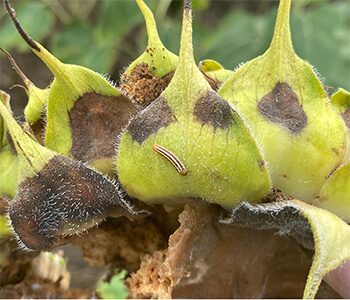Ride Along Series with Strategic Account Manager
Sep 13, 2021
Name: Chris Thompson
Hometown: Canton, Kansas
Territory: Groveland, Inman and Buhler
What are the current growth stages of the crops you are scouting for?
The corn I have been scouting for is in the mature stage and is to black layer and some growers in my area are already in the process of harvesting their corn. Most soybean acres are in middle of pod fill stage. One key component right now with soybeans are the moisture levels, so any rain we get is helpful to the development of the crop. Lastly, milo is in the head filling stage, and mostly everything is flowered and is trying to fill the berry.
Are you seeing any insect and/or disease pressure? If so, what are you seeing?
Podworms along with Sudden Death Syndrome (SDS) pressure is high in soybeans right now. As soybeans begin to fill, the pods, if you do not keep a lookout for podworms, have the potential to damage soybeans through defoliation and from feeding on pods. In milo acres I am seeing head worms that are attempting to eat at the grain. For the growers that currently have cover crops planted, we have been seeing army worms. Lastly, there have been sunflower moth caterpillar detected which have been eating at the heads of the flower. Sunflower moths fly to developing heads of the flower and lay eggs at the bases of florets. From there, you have caterpillars with brown stripes and light heads that feed and bore into the head of the plant. This has the potential to cause Rhizopus, a head rot fungus.
Based on the growth stages and environmental factors that you are seeing, what recommendations are you giving your growers today?
It is critical to continue to apply fungicides and insecticide passes to lower the insect and disease pressure they are seeing.
In order to help set a grower up for success, what is one thing you will do in the next 30 days to achieve that goal?
I have encouraged growers to pick the best varieties for the environmental conditions we are in. Next, I recommend making a fertility plan, so they know what decisions they will potentially have to make up front for the health of their crops. Lastly, we are in the process of planning for the next crop year.
Hometown: Canton, Kansas
Territory: Groveland, Inman and Buhler
What are the current growth stages of the crops you are scouting for?
The corn I have been scouting for is in the mature stage and is to black layer and some growers in my area are already in the process of harvesting their corn. Most soybean acres are in middle of pod fill stage. One key component right now with soybeans are the moisture levels, so any rain we get is helpful to the development of the crop. Lastly, milo is in the head filling stage, and mostly everything is flowered and is trying to fill the berry.
Are you seeing any insect and/or disease pressure? If so, what are you seeing?

Podworms along with Sudden Death Syndrome (SDS) pressure is high in soybeans right now. As soybeans begin to fill, the pods, if you do not keep a lookout for podworms, have the potential to damage soybeans through defoliation and from feeding on pods. In milo acres I am seeing head worms that are attempting to eat at the grain. For the growers that currently have cover crops planted, we have been seeing army worms. Lastly, there have been sunflower moth caterpillar detected which have been eating at the heads of the flower. Sunflower moths fly to developing heads of the flower and lay eggs at the bases of florets. From there, you have caterpillars with brown stripes and light heads that feed and bore into the head of the plant. This has the potential to cause Rhizopus, a head rot fungus.
Based on the growth stages and environmental factors that you are seeing, what recommendations are you giving your growers today?
It is critical to continue to apply fungicides and insecticide passes to lower the insect and disease pressure they are seeing.
In order to help set a grower up for success, what is one thing you will do in the next 30 days to achieve that goal?
I have encouraged growers to pick the best varieties for the environmental conditions we are in. Next, I recommend making a fertility plan, so they know what decisions they will potentially have to make up front for the health of their crops. Lastly, we are in the process of planning for the next crop year.